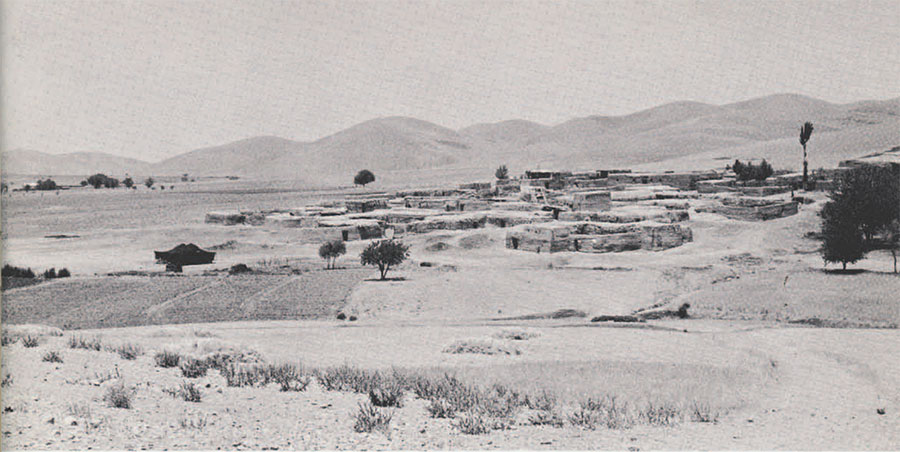
 In 1956, while both graduate students in anthropology at the University of Chicago, Maxine R. Kleindienst and I wrote a short article for the departmental journal. It appeared under the title “Action Archaeology: The Archaeological Inventory of a Living Community.” In 1959-1960 I had a chance to put some of the suggestions made in that article into practice. At that time I spent several months in Iran conducting an ethnographical study for archaeological purposes. The work was supported by a National Science Foundation Regular Post-doctoral grant and was carried out under the auspices of the Iranian Prehistoric Project of the University of Chicago and University of Teheran (directed by Professor R.J. Braidwood). The major focus of this study was a village in western Iran which may be called Hasanabad, though that is not its real name. It lies beside a large river not far from a sizable provincial administrative center. The population of Hasanabad is about two hundred and is made up almost exclusively of sharecropping peasants. The principal focus of the study was the economy and material culture of Hasanabad, but it was also concerned to some extent with the documentation fo social organization.
In 1956, while both graduate students in anthropology at the University of Chicago, Maxine R. Kleindienst and I wrote a short article for the departmental journal. It appeared under the title “Action Archaeology: The Archaeological Inventory of a Living Community.” In 1959-1960 I had a chance to put some of the suggestions made in that article into practice. At that time I spent several months in Iran conducting an ethnographical study for archaeological purposes. The work was supported by a National Science Foundation Regular Post-doctoral grant and was carried out under the auspices of the Iranian Prehistoric Project of the University of Chicago and University of Teheran (directed by Professor R.J. Braidwood). The major focus of this study was a village in western Iran which may be called Hasanabad, though that is not its real name. It lies beside a large river not far from a sizable provincial administrative center. The population of Hasanabad is about two hundred and is made up almost exclusively of sharecropping peasants. The principal focus of the study was the economy and material culture of Hasanabad, but it was also concerned to some extent with the documentation fo social organization.
Various practices and objects which are in daily use in many rural Near Eastern communities today originated some eight to nine thousand years ago during the early village era of prehistory (spinning wool and goat’s hair with a simple spindle and whorl, weaving cloth from the homespun yarn, methods of construction of mud buildings, together with some architectural features such as the way in which a door is hung, and so on). Detailed information on such material culture is of obvious aid in interpreting certain archaeological remains of prehistoric settlements. More importantly, however, an ethnographic study of a present-day village provides a wealth of data (obtainable in no other way) which serves as a basis for extrapolation to the entire way of life in a prehistoric community. If we have available such things as census figures and other statistics, descriptions of diet, details of agricultural and pastoral practices as related to subsistence and social organization for even a few contemporary villages (though the more the better), we are in a far better position to understand at least the economic organization and closely related aspects of life in prehistoric villages of early food-producers.
In the month of November, I took up residence with an American missionary couple who live near Hasanabad. I should like to acknowledge my deep gratitude to them for taking me into their h ome and for helping me in innumerable ways during, and after, my stay in Iran. Late fall weather in the Hasanabad region is rather cold and damp, and there is little agricultural activity. However, this is the season for reg-weaving by the village women. My interest in this activity enabled me to visit a number of homes, and thus to begin the all-important anthropological process known as “Establishing Rapport,” that is, getting one’s foot in the door. Most of the villagers eventually accepted–at least outwardly–my explanation of my presence: that I was interested in learning their language (which is an unpublished dialect called “Laki,” and is closely related to Persian and Kurdish) and customs, and intended to write a book about them. However, life in Hasanabad was not very comfortable for the people at the time of my study. All the peasants are sharecroppers, that is, they do not own the land they work, but in exchange for their lavor and that of their draft animals they receive two-thirds of the harvest. Ordinarily this return, plus the income from a few minor activities such as selling wood, or fish from the river, would be sufficient to maintain a family from one year to the next, but for the two previous years the crops had been almost completely destroyed at harvest time by an insect infestation. This meant that many of the people were now on the verge of starvation. Some families had already been forced to leave the village in hopes of finding work in the city, or with another landlord who would stake them to a new start. The rest of the villagers were hanging hopes of a better harvest this year. Their hopes were not realized: the spring, 1960, crops were also largely destroyed by the insects. I have heard more recently, however, that agricultural conditions are now improved.
The Hasanabad land is owned by a family resident in the nearby city, some four hours’ walk from the village. The sharecroppers are not tied to the land, though most of them cultivate part or all of the same land worked by their fathers, as will their sons after them. An ordinary villager cultivates a juft of land. Juft means ” a pair” in Persian, and refers to the team of oxen which, with the man who directs them, is the basic work unit. One man’s juft consists of many separate plots, erratic in shape and scattered all over the hills surrounding the village. One man may have twenty or thirty such plots on which, in a good year, he will ideally plant the following: 100 mann (660 pounds) of wheat, 50 mann (330 pounds) of barley, 10 to 20 mann (66 to 132 pounds) of chickpeas, 5 mann (33 pounds) of maize, 10 mann of goynna (66 pounds of a leguminour cattle fodder,) and 5 mann of nuzhi (33 pounds of a leguminous crop eaten by people). The most important crops are wheat and barley, and a ten-fold yield is considered excellent. Melons are sometimes grown, also, and if properly taken care of, are a very good cash crop. Melons and maize are summer, irrigated crops; chickpeas are grown in late spring and should receive at least some water; the other crops are usually planted in the fall and depend on winter rainfall.
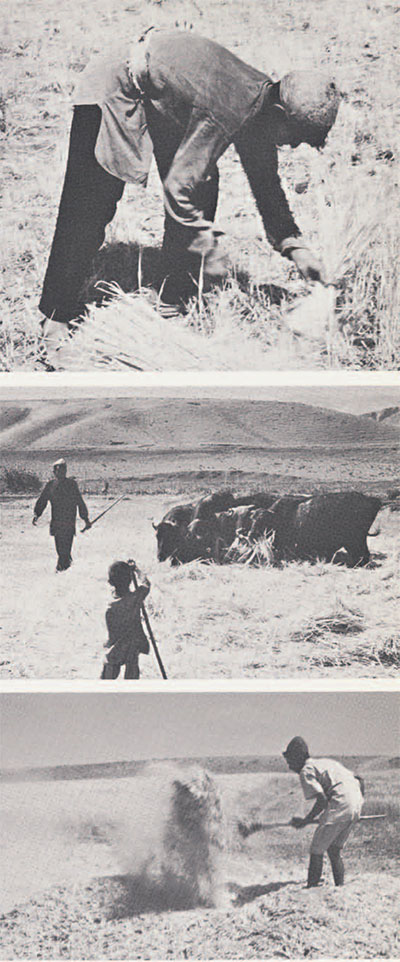
(Middle) Grain being threshed by the trampling of oxen.
(Bottom) Grain being winnowed with the use of a wooden fork and a slight breeze.
Wheat and barley are sown broadcast in the early fall, soon after the rains begin, and are reaped with sickles in June or July. Threshing is done by trampling, or by use of a sledge with revolving wooden paddles. The grain is winnowed by tossing it in the air with a wooden fork to let the wind blow out the chaff; sometimes a large, round sieve-like basket is also used in winnowing. The villager receives only two-thirds of the proceeds of his work, the other one-third of the crops goes to his landlord whom he very seldom sees. The peasant’s share of the wheat will be ground into flour to make bread, his staple dietary item. Wheat not immediately taken to the mill is stored in the courtyard or living room in underground pits.
The villager’s other major resource is his small flock of sheep and goats. Most families in Hasanabad had no more than four or five of these animals, but they are important because they belong solely to the villagers, the landlord has no claim on them. A few people also have a cow and several have donkeys, most have a fowl or two. The milk produced by sheep, goats, and cows is an important part of the diet in spring and summer, though it is seldom consumed as such but is made into a series of secondary products (principally cheese and a kind of buttermilk–dugh–made from churned yogurt). The standard diet items are whole-wheat bread and sweet tea. The bread is made daily by each village housewife and, especially when hot, is very good. The tea and the hard loaf sugar to sweeten it come from the city and are both rather expensive. Meat is rarely eaten, especially when times are hard. The commonest source of protein is eggs; chicken is sometimes eaten, but the sheep and goats are not voluntarily killed for their meat. Mutton or goat meat will be eaten only if an animal has died from disease or has been wounded or killed in some way. During the winter of 1959-1960, a goat belonging to a family in a nearby village was attacked by a wolf and mauled so badly before rescue that it later died. The owner sold the meat to recoup some of his loss. However, the normal practice is to sell all young males from the herds the fall after their birth, females are kept to maintain the flocks and to provide milk. Every few years one or two of the huskier young males are kept back as stud animals. All sheep and goats are shorn in the spring; some of the wool and hair is kept by the family for spinning and weaving into various items; the rest is sold in the city. Wool is also sometimes made into felt coats, hats and rugs; goat skins are made into containers for water or dugh.
The ordinary Hasanabad family occupies a mud house of three or four rooms opening onto a walled court, which has a gate to one of the village streets. Inside the courtyard there may also be one or more outbuildings, such as a stable (the villagers also use subterranean stables which are excavated beneath the courtyards) or storage rooms for wood, straw, or dung-cake fuel. All these surface buildings are made of sun-dried mud (not adobe brick) mixed with chaff and laid up in courses to form walls. The walls are ordinarily plastered inside and out, and are roofed with poplar beams, smaller branches and brush, all packed down by layers of dirt and mud and sealed with a coat of mud and chaff plaster. Doors are usually made of wood planks, sheets of corrugated iron, or flattened gasoline tins, though there are a few wattle-and-daube doors also. The door is mounted on a post which is held to the wall at the top by a shorter, forked post imbedded in the mud. The bottom of the doorpost pivots on a stone- or wood-floored door socket. This method of hanging a door is found in various parts of the Near East today. The principle is exactly the same as was used in the prehistoric village of Jarmo in northern Iraq and is also familiar from later Sumerian and Babylonian times.
Cooking is done in the living room (or outside in the courtyard in hot weather) over an open fire. The hearths are stone-lined; fuel is usually dried animal dung, supplemented by brush gathered from the thickets along the river. A careful housewife sweeps the floor and cleans out her hearth at least once a day. She dumps the refuse in a corner of the courtyard or onto one of the midden heaps which nearly surround the village. Dirt for construction purposes is often simply dug from the area around the village, and these quarry-pits soon become dump areas and latrines. During the winter the stable floors are cleaned nearly every day and the resulting dung is also piled up at the outskirts of the village. Here it is left until spring when it is used for the manufacture of dung-cake fuel. The midden areas on the village perimeter contain litter of all sorts: old bits of cloth, worn out rubber-tire shoe soles, bones, sticks, paper, goat and occasionally wild sheep horns and horn cores (because meat is so rarely eaten the animal remains are rather scarce), rusty pieces of kerosene tin and iron, bits of wool, string, plastic and wire, human and animal feces, occasional bits of broken tea saucers.
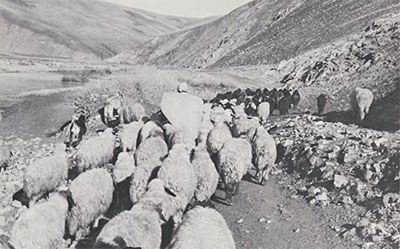
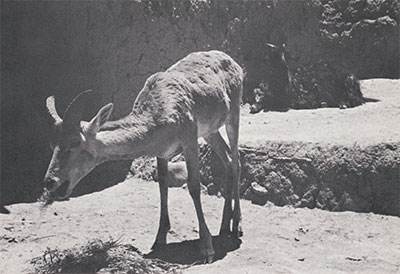
The most important room of the dwelling complex insofar as the daily life of the family is concerned is the living room. It is usually rectangular in plan and has a hearth approximately in the center of the packed-earth floor. At the end of the room opposite the door, the family bedding and floor coverings are piled up during the day. Nearby is a locked chest containing the family valuables (for instance, tea, sugar, cloth, a few heirlooms, beads destined to be strung into necklaces or anklets by the women). There may be one or two grain storage pits in the corners of the living room. These are bell-shaped holes about one meter in diameter at the top and about a meter deep, in which unmilled wheat is stored until ready to be ground into flour. When empty these pits are convenient trash containers.
Some of the items of household equipment to be found in most Hasanabad homes are the following: an iron plate for cooking bread, a flour sifter, a bread board, some kind of metal support for holding vessels above the fire (this is often a small squat tripod), a pair of tongs or a poker, a few pots and pans, two or three cloth-covered wickerwork potlids, one or two small metal bowls, a metal tablespoon and a large wooden spoon used, among other things, as a dipper for dugh, a tea kettle, a tea pot, two or three tea glasses with saucers and a small tray, a wooden sugar bowl, a sugar hatchet, a basketry tray for draining rice (eaten on feast occasions), or perhaps a wooden beater for pulverizing meat, one or two steel awls with wooden handles, large and small steel needles, an axe or adze, two or three spindles, a kerosene lamp, a few small boxes of matches, one or two woven rugs, a felt mat, two or three quilts, two or three bolsters, a woven bag to hold salt, a goatskin bag for water or dugh, possibly a mortar and pestle for pounding salt or meat. The men usually have pocket knives. A few people also have rotary querns but these are not often used, grain being usually ground at a power-driven mill in a nearby village or in the city.
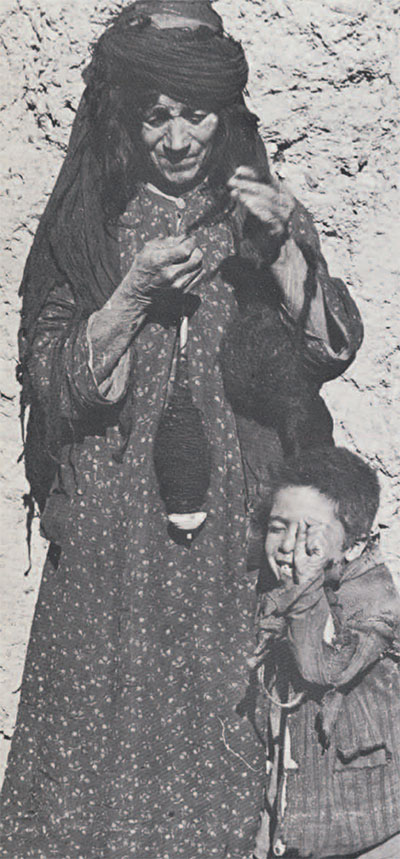
Pottery is not made and is seldom used in Hasanabad. Several blue-glazed, wide-mouthed jars of a type manufactured in Hamadan were noted hanging in various living rooms, but only one was seen in use (filled with dugh to be taken into the city and sold). On two occasions plainware bottle-like jars were seen being used for drinking water. The usual containers are tin and tinned-copper bowls and pots bought in Kermanshah. Many of these are typical Persian cooking vessels of the type called dig and come in various sizes. A few of the village men weave baskets and trays of willow shoots (this can be done only in winter when the shoots are supple) which they sell in town or to their neighbors. The use of goatskin water and dugh containers has been mentioned.
Wooden spindles with wooden whorls are bought from wandering gypsy-like folk called “Kawli.” The Kawli also make wooden sugar bowls, large wooden spoons, and other wooden items for sale to villagers or in the city bazaars.
Weaving is done on a simple vertical or horizontal loom which has a shed but no shuttle. Either wool or goats’ hair or a combination of both is woven into rugs, bags to hold salt, horse blankets (though only a very few men had horses at the time of the study), saddle bags, and feed bags. Cords and belts are produced by braiding.
The Hasanabad villagers live in elementary families (father, mother, children), though sometimes the father’s old parents are also members of the household. This group is the basic social and economic unit of the village. Clans and lineages are not recognized in Hasanabad, and only a few instances of some form of extended family exist in this village. The only organizations below the village level and above that of the family are cooperative work groups. The most important of these are the ones organized to take care of the sheep and goat flocks. Because any one family owns only a few animals, several families pool their animals, then the men and boys take turns leading them to pasture and watching over them. Other such work groups are formed among the men to build and maintain fish traps in the river. They are also formed among the women to share the milk yield from their animals, so that each family in turn has a large quantity of milk once or twice a week to make into dugh or cheese, instead of a very small daily quantity.
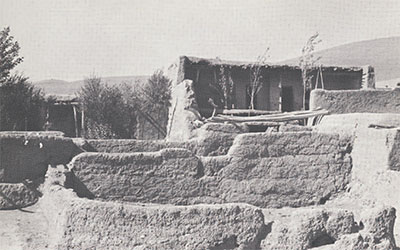
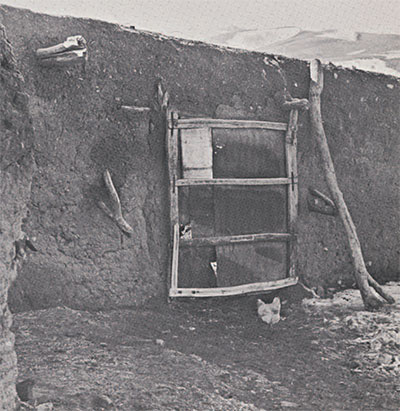
Hasanabad has a kadhoda, a head man, who is appointed by the landowning family to represent its interests in the village. This man also represents the villagers to the government, most importantly in the matter of conscription. It is the kadkhoda’s task to maintain a list of the local young men who are eligible for army duty. There is also a village council (because of the severe economic stress in the village, the council was not active during the time of my study). It consists of five men elected by the village men from among themselves. Theoretically, the council administers the village “welfare fund,” a sum derived from the sale of one tenth of the total harvest. This fund is meant to be used to improve the village–to repair roads and irrigation canals, improve the water supply, construct latrines, and so on.
The villagers are ostensibly Shi’ite Muslims, but there is no mosque in the village and the people are not very well informed about their religion. They do have a firm belief in jins and peris, most of whom seem to be malignant, and a lively fear of the Evil Eye. Amulets and charms, especially those effective against the Evil Eye, are worn by all children and are often seen attached to household objects, such as the skin bag used for churning yogurt.
Besides the work in Hasanabad, I spent three weeks in another community a few miles away. This was a Kurdish village occupied only in fall and winter, the inhabitants deserting their stone houses in the springtime and moving up onto the nearby mountain with their sheep and goats, where they live in goats’ hair tents until September or October. They do plant some wheat and barley, but their main interest lies with their flocks. This pattern of seasonal migration is probably as old as the settled farming pattern exhibited by Hasanabad, the origins of both going back more than eight thousand years into the past. The tools and other domestic equipment, the techniques of pastoralism, and the details of the economic organization in this Kurdish community, especially as compared with Hasanabad, were therefore of considerable relevance to my study.
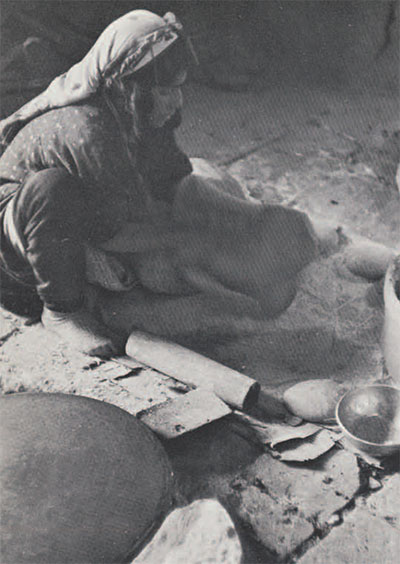
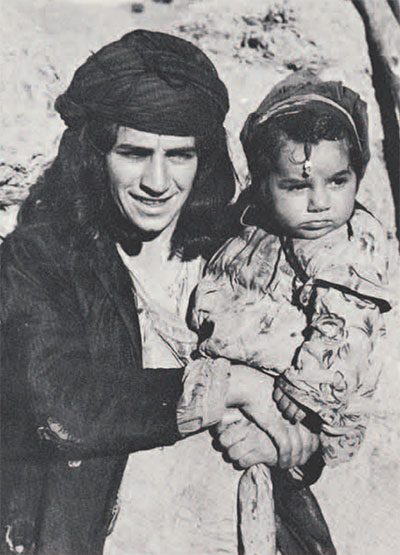
Most of the household equipment used in the Kurdish village is very similar to that at Hasanabad and the house complexes, though made of stone instead of mud, are also similar. However, each family owns a black tent as his summer home (tow or three Hasanabad families also own black tents which are sometimes used for a few weeks during the summer in higher pastures across the river). These tents are set up at the same sites year after year. The first move is made in mid-May to an upland valley about two hours’ walk above the village. The tent sites are easily recognized by the stone-lined hearth and the stone platform which mark each one. Often an animal pen–a low circular wall of unmortared limestone rocks–lies nearby; this is used for the young lambs and kids, the older animals being bedded down directly in front of the tents. The stone platform is used to hold bedding and the dugh and water bags.
In July the Kurdish villagers move on up to a high pasture only a few hundred feet below the peak of their mountain and here they spend the rest of the summer. In late August or early September they move down, again in two stages, and by late October they are back in their stone village once more.
The Iranian data gathered in 1959-1960 plus that available in other studies already published suggests the following kinds of generalizations about life in the earliest villages (approximately 7000-6500 B.C.): The biological nuclear family (father, mother, and offspring) probably included about five people. Child mortality was high, 30% to 40% of all children born probably died before they were three years old, and many of them died within the first few weeks or months of life. Of those who did not die, the boys probably had a life expectancy of no more than fifty years, the girls thirty to forty years. Unless specific cultural restrictions did not permit it, the girls would have married well before their twentieth year, and would have produced about six children (this is an average figure based on my Hasanabad data; several thirty- to forty-year-old women had eight, nine, ten, or eleven children, some had three or four, a few had none). No ordinary person voluntarily remained unmarried.
As to the economic organization of the early villages: most of them relied upon some combination of sheep-goat pastoralism with the cultivation of wheat, barley, and legumes, plus varying use of available wild plant and animal foods (hunting of gazelle, deer, wild sheep or goat, gathering pistachio nuts, acorns, wild fruits, “greens,” etc.). The crops could all have been handled approximately as they often are now (sown broadcast, cut with sickles or reaping knives) but were possibly threshed with a mortar and pestle rather than by trampling. There is as yet no evidence that the earliest farmers used plows and draft animals, so the ground must have been prepared with hoes or digging sticks. The grain may have been parched and eaten dry, or ground on saddle querns or crushed in mortars by the women and then made into gruel or porridge, or a simple kind of unleavened bread not unlike that produced in Hasanabad today. In spring and early summer milk products would have formed an important part of the diet. The flocks could also have been handled essentially as they are today: all females were kept, nearly all of the year’s crop of males were culled out each fall and slaughtered for meat and hides, or were killed as needed through the winter. Wool and goats’ hair were used for the manufacture of cloth and rope, just as they are now in Hasanabad. As is the case now, part or all of some communities probably moved with their flocks to higher pastures in the spring and summer. There is some archaeological evidence at the sites of Tepe Serab and Tepe Guran near Kermanshas for the prehistoric existence of these seasonally migrant communities.
“Action archaeology,” ethnography for archaeological purposes, is currently gaining more attention from those interested in prehistory. Similarly oriented investigations are now underway among the Bushmen and some other African groups. George Quimby has even said ( in a book review for American Antiquity, July issue, 1961), “…the archaeologists are among the relatively few anthropologists left who are interested in ethnology and tribal cultures. This, of course, is a healthy condition for archaeology, and I predict that ultimately archaeologists will be the practitioners of what I knew as ethnology in my student days 25 years ago.” At any rate, to judge from current trends in American cultural and social anthropology, it seems very likely that in future the prehistorian must give some serious thought to obtaining the kind of ethnographic information necessary to him. This may simply mean that he must influence graduate students or other anthropologists, or it may occasionally mean that the archaeologist himself turns parttime ethnologist.
- Sheaves of grain being brought from the field to the threshing floor on donkey back in a goats’ hair net.
- Tent sites in the high pasture where the Kurdish villagers spend the hottest part of the summer. Three tent sites are visible; one in the foreground ( with stone-lined hearth slightly to right of center) and two in the background ( with prominent stone benches and lines of stones marking the front of the tent emplacement ). The picture was taken in early spring, several weeks before the villagers moved up here.
- A reed and willow branch screen being manufactured in a village very near Hasanabad. The reeds (lighter in color) are bound together with goats’ hair cords which are tied to rocks. The rocks are thrown rapidly from one side to the other in a sequence which produces the patterning of the cords.
- Tents of the Kurdish villagers encamped at the first stage of their move up the mountain. After four to six weeks here they will move on to the highest pasture just below the peak of the mountain. The tents are made of reed screens. Closely related families tend to pitch tents near each other.




